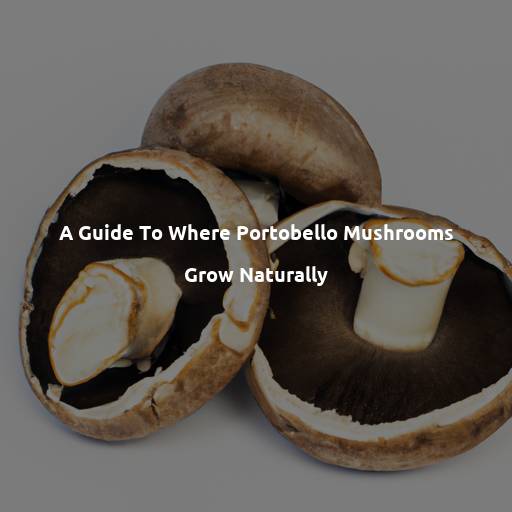Introduction to Portobello Mushrooms
Portobello mushrooms, scientifically known as Agaricus bisporus, are one of the most popular varieties of mushrooms enjoyed by culinary enthusiasts worldwide. With their distinctive meaty texture and robust flavor, portobellos have become a staple ingredient in many dishes. Whether you’re a seasoned chef or a home cook looking to experiment with new flavors, understanding the basics of portobello mushrooms is essential. In this section, we will delve into the characteristics and culinary value of these delectable fungi, giving you a comprehensive introduction to portobello mushrooms. Throughout the guide, we will explore their natural habitat, growing conditions, and offer tips on how to cultivate them successfully at home. So, let’s embark on this journey into the world of portobello mushrooms and uncover the secrets behind their unique allure.
Habitat and Growing Conditions
Portobello mushrooms, scientifically known as Agaricus bisporus, are typically found growing in specific habitats and under specific conditions. In order to successfully cultivate these mushrooms, it is important to understand their natural habitat and the ideal growing conditions.
Portobello mushrooms thrive in temperate regions with mild climates. They prefer loamy soil that is rich in organic matter and has good drainage capabilities. Additionally, a slightly acidic to neutral pH level ranging from 6 to 7 is optimal for their growth.
These mushrooms are usually found growing in grassy areas, such as meadows, pastures, and fields, where they can benefit from the organic matter present in the soil. They tend to grow in clusters, often near decaying organic materials like leaves or wood.
In terms of temperature, portobello mushrooms favor a moderate range between 60 to 75°F (15 to 24°C). However, they can also tolerate lower temperatures, around 50°F (10°C), and higher temperatures up to 85°F (29°C).
To create an ideal growing environment for portobello mushrooms, it is crucial to maintain proper humidity levels. These mushrooms require high humidity, typically between 80% to 90%, for successful growth. This can be achieved by misting the growing area regularly or by placing a humidity tray nearby.
It is important to note that portobello mushrooms are light-sensitive and require limited exposure to light during the growing process. A dark and cool environment is favorable for their development, especially during the initial stages of growth.
By understanding the natural habitat and growing conditions of portobello mushrooms, you can recreate these conditions at home to cultivate your own delicious harvest. With the right combination of soil, moisture, temperature, and light, you can enhance your portobello growing success and enjoy the fresh and flavorful results.
Natural Range of Portobello Mushrooms
Portobello mushrooms (scientific name: Agaricus bisporus var. portobello) have a natural range that spans across various regions. These mushrooms are primarily found in temperate climates around the world. They can be found growing in the wild in several countries, including the United States, Canada, Mexico, Australia, and parts of Europe.
Portobello mushrooms thrive in areas with rich organic matter, such as grasslands, pastures, and meadows. They typically grow in nutrient-dense soil that is well-drained and has a pH level between 6.0 and 7.0. These mushrooms prefer moderate temperatures, ranging from 55 to 70 degrees Fahrenheit (13 to 21 degrees Celsius).
In the wild, portobello mushrooms often appear alongside other fungi in forests or open spaces. They have been spotted growing in groups or individually near trees, shrubs, or decaying plant matter. These mushrooms require certain environmental conditions to develop, including ample moisture and proper air circulation.
It’s important to note that while portobello mushrooms are considered wild fungi, they are also extensively cultivated worldwide due to their popularity as a culinary ingredient. The adaptability of portobello mushrooms allows them to be grown in controlled environments, such as indoor farms or home gardens, providing opportunities for enthusiasts to cultivate them in a more controlled setting.
Understanding the natural range and preferred environments of portobello mushrooms can greatly enhance your success in growing these delicious fungi at home. So, let’s now dive into the details of creating suitable conditions and identifying indigenous portobello habitats to further explore the world of portobello mushroom cultivation.
Preferred Environments for Portobello Mushrooms
Portobello mushrooms thrive in specific environments that provide the ideal conditions for their growth and development. Understanding the preferred environments for portobello mushrooms is crucial for successful cultivation. Here are key factors to consider when creating an optimal environment for portobello mushroom cultivation:
1. Temperature: Portobello mushrooms prefer a temperature range of 60-70°F (15-21°C) during their growth cycle. Maintaining a stable and consistent temperature is essential to promoting healthy mushroom growth.
2. Humidity: These mushrooms thrive in high humidity conditions, typically ranging between 80-90%. To create the required humidity levels, misting the growing area regularly or using a humidifier can be beneficial.
3. Light: Portobello mushrooms are not dependent on light for their growth, making them well-suited for indoor cultivation. However, indirect light can be beneficial during the fruiting stage to stimulate the development of healthy mushroom caps.
4. Air Quality: Adequate air exchange is crucial for portobello mushrooms’ growth. It helps maintain proper oxygen levels and removes carbon dioxide, preventing the build-up of harmful gases. Consider using a fan or ventilation system to ensure a steady flow of fresh air.
5. Substrate: Portobello mushrooms have a preference for nutrient-rich substrates like composted horse manure, straw, or a blend of both. The substrate should be pasteurized or sterilized to eliminate competing organisms and provide an optimal environment for mushroom colonization.
By providing these preferred environmental conditions, you can create a conducive space for cultivating portobello mushrooms. Remember to monitor and adjust temperature, humidity, airflow, and substrate conditions as needed throughout the growth cycle.
Identifying Indigenous Portobello Habitats
Portobello mushrooms (Agaricus bisporus) are native to various regions around the world, making it important to understand their natural habitats for successful cultivation. These mushrooms typically thrive in temperate climates, favoring specific environmental conditions. By identifying the indigenous habitats of Portobello mushrooms, you can replicate these conditions to enhance your growing success.
1. Soil Composition:
Portobello mushrooms prefer a nutrient-rich soil with good drainage. They commonly grow in areas with organic matter, such as decomposing leaves and wood. Look for areas with soil that is dark and crumbly, indicating a healthy composition for Portobello cultivation.
2. Moisture Levels:
These mushrooms thrive in a moist environment. In their natural habitats, Portobello mushrooms are often found in locations with high humidity, such as forest floors or areas near water bodies. Adequate moisture is crucial for their growth, as it helps with the formation of fruiting bodies.
3. Light Exposure:
While Portobello mushrooms do not require direct sunlight, they do benefit from indirect light exposure. Look for areas where sunlight penetrates the forest canopy or spaces where filtered sunlight is available. This provides the mushrooms with the necessary light for photosynthesis, contributing to their overall development.
4. Temperature Range:
Portobello mushrooms prefer temperatures ranging from 55°F to 65°F (12°C to 18°C). They thrive in cooler climates and are typically found in regions with moderate temperatures. When identifying indigenous habitats for Portobello mushrooms, consider locations with a temperate climate that aligns with their preferred temperature range.
5. Growing Substrates:
Portobello mushrooms have specific preferences for growing substrates. These include compost, straw, and other organic materials rich in nutrients. Look for areas where these substrates are naturally abundant, such as decomposition sites or forest floors enriched with decaying matter.
By identifying indigenous Portobello habitats, you can replicate these conditions in your own cultivation practices. Consider the soil composition, moisture levels, light exposure, temperature range, and suitable growing substrates. Implementing these factors into your growing environment will enhance your chances of success in cultivating these delicious and nutritious mushrooms at home.
Growing Portobello Mushrooms at Home
Portobello mushrooms can be easily grown at home, allowing you to enjoy their delicious taste and health benefits right from your own garden. Here are some tips to help you successfully cultivate portobello mushrooms in the comfort of your home:
1. Choose the Right Growing Medium: Portobello mushrooms thrive best in a compost-based growing medium. You can create your own growing medium by combining organic materials like straw, hay, and horse or poultry manure. This mixture provides the essential nutrients and moisture retention that portobellos need to flourish.
2. Prepare the Growing Containers: Select a container that is deep enough to accommodate the growth of the mushrooms. Sterilize the container to eliminate any potential contaminants. Fill the container with the compost-based growing medium, leaving about an inch of space at the top.
3. Inoculate the Growing Medium: Purchase portobello mushroom spawn from a reputable supplier. Sprinkle the spawn evenly over the surface of the growing medium in the container. Gently press the spawn into the soil and cover it with a thin layer of additional compost or peat moss.
4. Maintain Proper Growing Conditions: Portobello mushrooms prefer moist and humid environments with temperatures ranging between 60°F and 70°F (15°C and 21°C). Place the container in a location that receives indirect sunlight or provide artificial lighting if necessary. Regularly mist the growing medium to maintain the required moisture level.
5. Monitor and Control the Environment: Keep a close eye on the growing conditions and make necessary adjustments as needed. Ensure proper ventilation to prevent the growth of mold or other undesirable fungi. Avoid overwatering, as excessive moisture can lead to rot.
6. Harvesting the Mushrooms: Portobello mushrooms are ready for harvest when the caps reach about 4-6 inches (10-15 cm) in diameter. Pick the mushrooms by gently twisting and pulling them out of the growing medium. Leave behind any small mushrooms to allow them to continue growing.
Remember, growing portobello mushrooms at home requires patience and care. With proper attention to detail and a conducive growing environment, you can savor the pleasure of freshly harvested, homegrown portobello mushrooms.
Conclusion: Enhancing Your Portobello Growing Success
With the right knowledge and understanding of the natural habitat and growing conditions of portobello mushrooms, you can enhance your success in cultivating these delectable fungi at home. By recreating their preferred environment of temperate regions, loamy soil, moderate temperatures, high humidity, limited light exposure, and proper airflow, you can create an ideal growing environment for portobello mushrooms. Remember to provide nutrient-rich substrates, maintain proper moisture levels, and monitor the temperature and humidity throughout the growing process. By doing so, you can enjoy the satisfaction of a bountiful harvest of fresh and flavorful portobello mushrooms. Happy growing!

